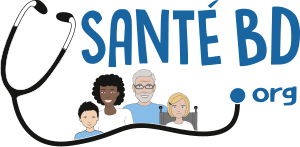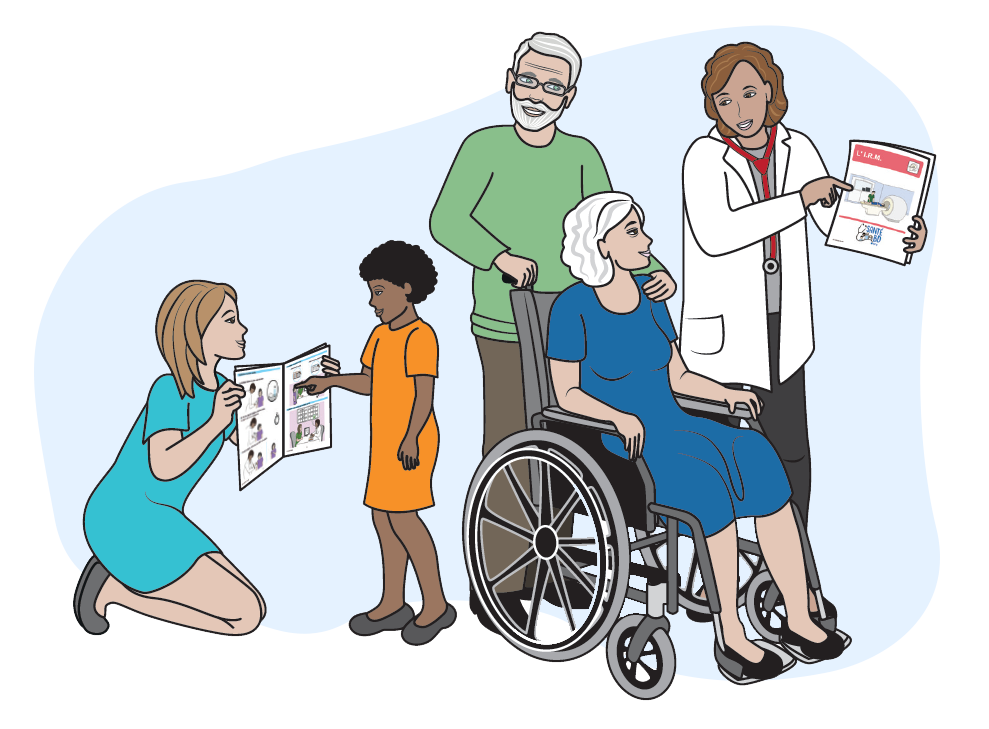Transcription textuelle de la BD The ER – What happens in the Emergency Room ?
What is the Emergency room ?
The ER is supposed to provide first aid and treatment as quickly as possible.
ERs are located in hospitals.
At the ER, caregivers are there every day and night.
The ER treats people with very serious health problems.
For example :
- A serious injury.
- Loss of consciouness.
- A very high fever.
- Very intense pain.
- A fracture.
- Difficulty breathing.
I arrive at the ER.
I go to the reception.
A person from the ER asks me who I am.
I give to the receptionist :
- my ID card
- my adress
- my health insurance card
- my supplementary health insurance card
A nurse comes to get me.
She takes me to a small examining room.
The person who came with me can stay.
The nurse puts a bracelet around my arm with my name and numbers.
I must not take off the bracelet.
The nurse asks me questions.
See the booklet on « The nurse’s questionnaire. »
The nurse takes my vitals with a machine.
The nurse puts :
- An armband around my arm
- and a clip on my finger.
The machine provides information about my health.
The nurse takes my temperature.
There are different kinds of thermometers.
See the booklet on « I have a doctor’s appointment » – Page 21
She can prick the end of my finger to get a blood sample.
She can ask me to urinate in a small cup.
The nurse decides where I should go :
In the ER, the most serious cases get priority.
- If my situation is not serious I can wait in the waiting room
- If my situation is serious I am going to be treated right away.
A team of caregivers takes care of me.
On the team, there can be :
A doctor, assistant nurses, nurses, strecher-bearers.
The doctor comes to get me.
The person that came with me can stay by my side.
The doctor examines me.
He can ask his caregiving team :
- To give me medication.
- To give me a mask so I can breathe.
- To listen to my heart with a machine.
- To take a blood sample.
- To give me an IV drip.
See the document on « Blood samples ».
See the booklet on « IV drips ».
The doctor decides what to do with me.
- The doctor decides if I should go :
- Get an emergency treatment
- Perform other exams at the hospital
- Or go home.
I am going to receive immediate care in the ER.
If my situation is very serious, the caregivers take care of me right away.
If I have a fracture, I can get :
- A cast
- or a splint
If I have a large wound, I can get :
- a bandage
- stitches. See the booklet.
- a Band-Aid
If I am in pain and scared, there are ways to calm down.
See the booklet « MEOPA ».
See the booklet « Pain ».
I need to get more exams.
The doctor may need images of inside my body.
At the hospital, they can perform :
- An X-ray. See the booklet.
- an MRI. See the booklet.
- a CT. See the booklet.
- an ultrasound.
The doctor can send me to see another doctor at the hospital.
For example :
- a cardiologist
- a neurologist
- an ENT specialist (Ear-Nose-Throat)
- a dentist. See the booklet.
When the exams are finished, I am sent back to the waiting room.
I await the results of my exams : this could take a while.
I can wait for more than an hour.
The doctor explains my results to me.
Post-treatments and exams.
The caregiving team decides if :
I should stay at the hospital
or return home.
I stay at the hospital for several days.
A person that I know can stay with me.
At the hospital, I can get :
- other treatments
- more exams
- an operation
I return home.
Before leaving, a nurse asks if I am in pain.
If I came with someone, I return home with them :
- By car.
- By mass transit.
If I am alone, I can return home :
- In a light medical vehicle.
- In an ambulance.
- In a taxi.
Upon leaving the hospital or the ER, the doctor gives me :
- A prescription for the pharmacy.
- A letter and my results for my doctor.
- Medical advice.
This document is sponsored by :
The Fondation Handicap Malakoff Médéric, the Société Française de Médecine d’Urgence and the Fédération Hospitalière de France.
SantéBD Multilingual is a project supported by the Orange Foundation.
SantéBD booklets?
- On the internet: Visit the website: www.santebd.org
- On the SantéBD Channel Youtube
SantéBD booklets are free.
SantéBD is a project by the NGO Coactis Santé contact@santebd.org
SantéBD booklets are produced in partnership with different participants from the world of healthcare and working with disabilities. Illustrations by Frédérique Mercier.
Copyright Coactis Santé
The creation of this tool was made possible with the support of:
- la Fondation Handicap Malakoff Humanis
- la Fondation de France
- la mairie de Paris
- l’Assurance maladie
- la Caisse nationale de solidarité pour l’autonomie
- Santé publique France
This document was proofread by people with learning disabilities and respects the European Easy-to-Read Guidelines. These guidelines help to make information available for everyone.
For more information visit the website https://www.inclusion-europe.eu/easy-to-read/





